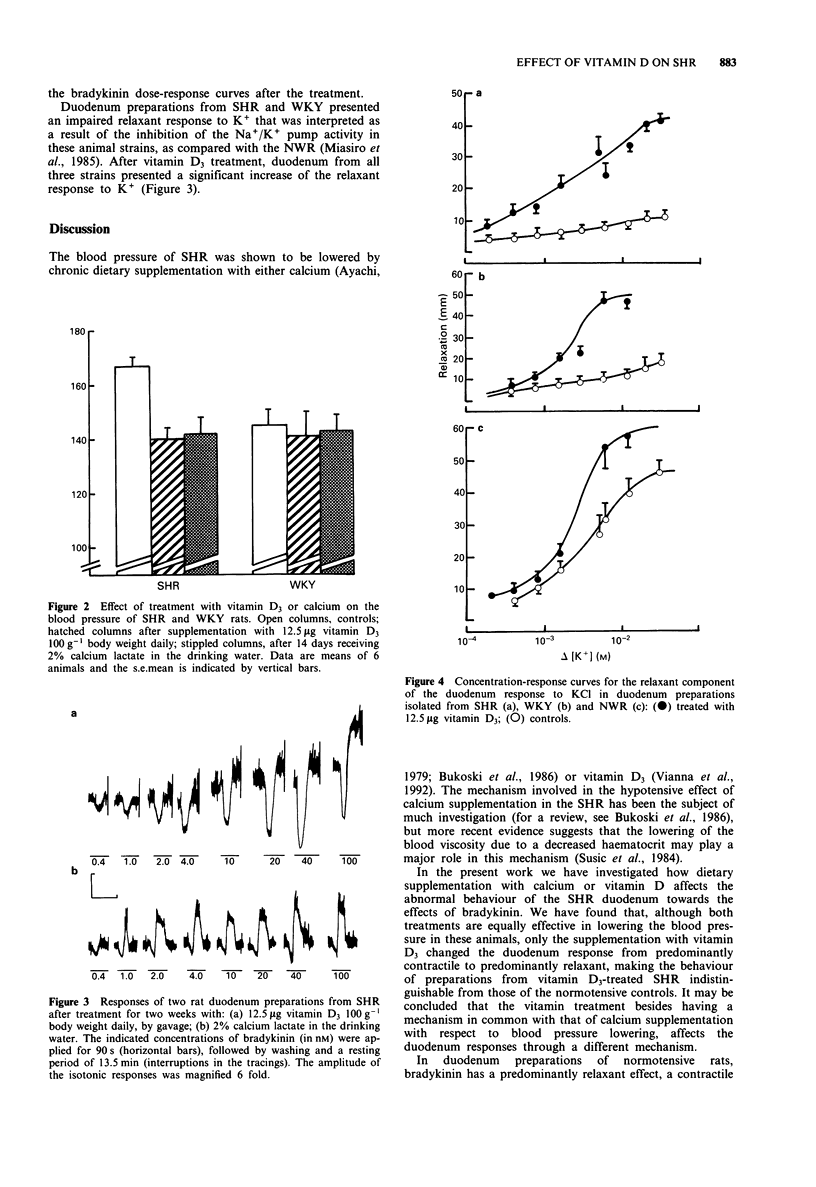Abstract
1. The diet of spontaneously hypertensive rats (SHR) and normotensive Wistar-Kyoto (WKY) and Wistar (NWR) rats was supplemented with either 2% calcium lactate in the drinking water or 12.5 micrograms vitamin D3 100 g-1 body weight daily by gavage, for 14 days. 2. The blood pressure of the SHR treated with either calcium or vitamin D decreased to the same levels as that of WKY and NWR. 3. The response to bradykinin of the SHR isolated duodenum, which is predominantly contractile, upon treatment with vitamin D (but not with calcium), became predominantly relaxant, approaching the normal behavior of the WKY and NWR duodenum. 4. The relaxant responses of the SHR and WKY duodenum to potassium were smaller than those of NWR, but treatment with vitamin D increased the response in all three rat strains. 5. It is concluded that, besides sharing the hypotensive effect of calcium, vitamin D treatment of SHR has an effect on the duodenum smooth muscle which might be due to calmodulin-dependent activation of calcium-dependent potassium channels.
Full text
PDF



Selected References
These references are in PubMed. This may not be the complete list of references from this article.
- Ayachi S. Increased dietary calcium lowers blood pressure in the spontaneously hypertensive rat. Metabolism. 1979 Dec;28(12):1234–1238. doi: 10.1016/0026-0495(79)90136-7. [DOI] [PubMed] [Google Scholar]
- Baba A., Fukuda K., Kuchii M., Ura M., Yoshikawa H., Hamada M., Hano T., Nishio I., Masuyama Y. Intracellular free calcium concentration, Ca++ channel and calmodulin level in experimental hypertension in rats. Jpn Circ J. 1987 Oct;51(10):1216–1222. doi: 10.1253/jcj.51.1216. [DOI] [PubMed] [Google Scholar]
- Bohr D. F., Webb R. C. Vascular smooth muscle membrane in hypertension. Annu Rev Pharmacol Toxicol. 1988;28:389–409. doi: 10.1146/annurev.pa.28.040188.002133. [DOI] [PubMed] [Google Scholar]
- Boschcov P., Paiva A. C., Paiva T. B., Shimuta S. I. Further evidence for the existence of two receptor sites for bradykinin responsible for the diphasic effect in the rat isolated duodenum. Br J Pharmacol. 1984 Oct;83(2):591–600. doi: 10.1111/j.1476-5381.1984.tb16523.x. [DOI] [PMC free article] [PubMed] [Google Scholar]
- Bukoski R. D., McCarron D. A. Altered aortic reactivity and lowered blood pressure associated with high calcium intake. Am J Physiol. 1986 Nov;251(5 Pt 2):H976–H983. doi: 10.1152/ajpheart.1986.251.5.H976. [DOI] [PubMed] [Google Scholar]
- Bukoski R., Lucas P., Drüeke T., McCarron D. Theoretical mechanisms of dietary calcium's antihypertensive action. Adv Exp Med Biol. 1986;208:389–396. doi: 10.1007/978-1-4684-5206-8_49. [DOI] [PubMed] [Google Scholar]
- Fernandez L. M., Massheimer V., de Boland A. R. Cyclic AMP-dependent membrane protein phosphorylation and calmodulin binding are involved in the rapid stimulation of muscle calcium uptake by 1,25-dihydroxyvitamin D3. Calcif Tissue Int. 1990 Nov;47(5):314–319. doi: 10.1007/BF02555915. [DOI] [PubMed] [Google Scholar]
- Gross M., Kumar R. Physiology and biochemistry of vitamin D-dependent calcium binding proteins. Am J Physiol. 1990 Aug;259(2 Pt 2):F195–F209. doi: 10.1152/ajprenal.1990.259.2.F195. [DOI] [PubMed] [Google Scholar]
- Hall J. M., Morton I. K. Bradykinin B2 receptor evoked K+ permeability increase mediates relaxation in the rat duodenum. Eur J Pharmacol. 1991 Feb 7;193(2):231–238. doi: 10.1016/0014-2999(91)90041-n. [DOI] [PubMed] [Google Scholar]
- Lucas P. A., Brown R. C., Drüeke T., Lacour B., Metz J. A., McCarron D. A. Abnormal vitamin D metabolism, intestinal calcium transport, and bone calcium status in the spontaneously hypertensive rat compared with its genetic control. J Clin Invest. 1986 Jul;78(1):221–227. doi: 10.1172/JCI112555. [DOI] [PMC free article] [PubMed] [Google Scholar]
- McCarron D. A. Calcium metabolism and hypertension. Kidney Int. 1989 Feb;35(2):717–736. doi: 10.1038/ki.1989.44. [DOI] [PubMed] [Google Scholar]
- Miasiro N., Paiva T. B., Pereira C. C., Shimuta S. I. Reactivity to bradykinin and potassium of the isolated duodenum from rats with genetic and renal hypertension. Br J Pharmacol. 1985 Jul;85(3):639–646. doi: 10.1111/j.1476-5381.1985.tb10559.x. [DOI] [PMC free article] [PubMed] [Google Scholar]
- Okada Y., Yada T., Ohno-Shosaku T., Oiki S. Evidence for the involvement of calmodulin in the operation of Ca-activated K channels in mouse fibroblasts. J Membr Biol. 1987;96(2):121–128. doi: 10.1007/BF01869238. [DOI] [PubMed] [Google Scholar]
- Paiva A. C., Paiva T. B., Pereira C. C., Shimuta S. I. Selectivity of bradykinin analogues for receptors mediating contraction and relaxation of the rat duodenum. Br J Pharmacol. 1989 Sep;98(1):206–210. doi: 10.1111/j.1476-5381.1989.tb16883.x. [DOI] [PMC free article] [PubMed] [Google Scholar]
- Pershadsingh H. A., Gale R. D., Delfert D. M., McDonald J. M. A calmodulin dependent Ca2+-activated K+ channel in the adipocyte plasma membrane. Biochem Biophys Res Commun. 1986 Mar 28;135(3):934–941. doi: 10.1016/0006-291x(86)91018-1. [DOI] [PubMed] [Google Scholar]
- Rinaldi G., Bohr D. F. Potassium-induced relaxation of arteries in hypertension: modulation by extracellular calcium. Am J Physiol. 1989 Mar;256(3 Pt 2):H707–H712. doi: 10.1152/ajpheart.1989.256.3.H707. [DOI] [PubMed] [Google Scholar]
- Sabia E. B., Tominaga M., Paiva A. C., Paiva T. B. Bradykinin potentiating and sensitizing activities of new synthetic analogues of snake venom peptides. J Med Chem. 1977 Dec;20(12):1679–1681. doi: 10.1021/jm00222a030. [DOI] [PubMed] [Google Scholar]
- Susic D., Mandal A. K., Kentera D. Hemodynamic effects of chronic alteration in hematocrit in spontaneously hypertensive rats. Hypertension. 1984 Mar-Apr;6(2 Pt 1):262–266. [PubMed] [Google Scholar]


